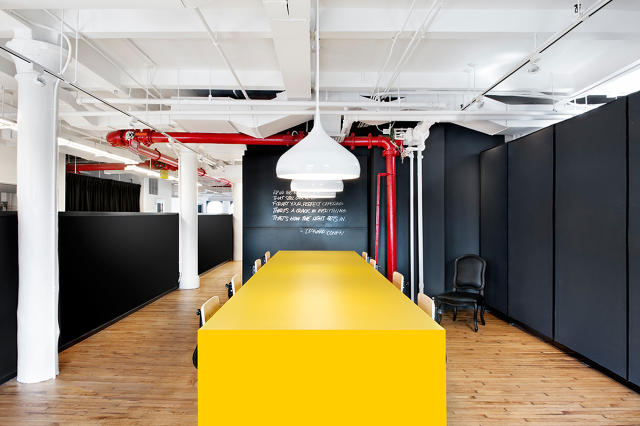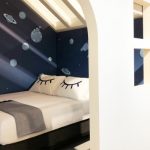here Is An Open office Any worker would love
it is imaginable to make a fantastic open workplace that maximizes creativity and minimizes annoyance, as a tour of branding firm Collins proves.
March 17, 2015
“I’m not a fan of the open place of business,” says Brian Collins, as we’re sitting within the open workplace house he and his partner Lee Maschmeyer designed for their New York city based branding agency Collins. Collins isn’t on my own in his basic aversion to piling staff on prime of every other within the identify of serendipity. but the ingenious crew at Collins requested for an open place of business plan. “the amount of vitality and the way a lot they liked being on prime of each and every different was improbable,” introduced Collins. Collins (the founder) was overruled. nobody, now not even the founders, has a separate workplace.
indeed, the open place of job is a polarizing phenomenon. whereas some argue there’s a creative byproduct from proximity to coworkers, others call it a cruel farce meant to save lots of companies cash, not improve worker productivity.

Most open workplaces do not work as a result of little concept goes into how they may be laid out. there is not any one-dimension-suits-all open place of job. the best work areas are designed with workers (and the kind of work they do) in mind, which is strictly how Collins approached its new space. “We recognized these core modalities of how we work,” defined Maschmeyer. “We had this need to create a place that flowed with our workflows.” The open floor plan, which includes a pen for the bulk of the creative staff, and a slab of desk for the product managers, is one such method the structure of the place of business facilitates work.
The research on designing for ingenious interactions has found that most spaces could raise informal interactions, however now not essentially creativity. The Collins companions recognize that. “How do you set ingenious groups in a good-knit staff together architecturally, so that they really feel permission to share concepts?” mentioned Maschmeyer.

the principle bull pen, the place the bulk of the workforce sits, is open—but purposeful. The are not any dividers between desks in order that the employees can see each other’s work and provide enter and help. “It was once a way to design serendipity into the experience,” defined Maschmeyer. but the setup also tries to create some semblance of privacy; no particular person sits going through another individual. The product managers sit in a separate house, giving them privacy, while also signaling their authority.
in fact, now not all sorts of work can flourish in a structureless setting. “loads of occasions when you find yourself cranking on stuff, lots of people want to get out of their heads,” cited Maschmeyer. For these moments, Collins created a library, which is by means of a long way probably the most ornate a part of the office. tons of of thick artwork and design books fill the black metal cabinets. other creative stimuli are perched on the shelves: a globe, a snow globe, kids’s constructing blocks. An old black-and-white movie plays on a display on one wall. anyone had left an Henri Matisse guide open on the desk. “The physicality of looking modifications the way you perceive one thing,” explained Collins. “the actual fact that you can take 5 or 6 books and take a look at them and see different patterns adjustments the way you look at things.”
On the other end of the ingenious spectrum, every so often people need more interplay with the work. For that, Collins has a space called the jungle gym, which seems extra like a windowless convention room than a children’s playpen. but within, individuals have permission to tinker, interact, and if want be, physique slam the work without interrupting people in the place of job. a couple of Collins’s most up to date digital interactive installations are displayed on the wall, simply asking to be performed with. The room also has extra normal electronic tools for more basic hacking.

Even the walls at Collins serve a objective. as an alternative of adorning with previous work or paintings, Collins uses the partitions so that you can show work in development. Forcing folks to walk by means of the imagery a couple of instances a day results in extra ingenious breakthroughs, Collins claims. “by using leaving up systemically complex projects on the wall,” explains Collins, “other people will see systemic patterns and make tips.”
When eager about find out how to design the workplace, Maschmeyer used to be impressed with the aid of MIT’s constructing 20, as chronicled in Stewart model’s How structures examine. constructing 20 was once a brief World war II-generation constructing on MIT’s campus that did not get torn down unless fifty five years later. regardless of its alleged transient standing, MIT students and professors arrange labs and studios in the makeshift work space. “What Stuart model discovered was the people who worked in the shoddy POS constructing were infinitely more happy and productive,” defined Maschmeyer. The Collins place of job is a long way from shoddy—it can be an attractive top-flooring ny office constructing with skylights, wooden floors, and authentic Danish mid-century up to date furniture. nevertheless it will pay homage to that thought. “when I was looking at what we’re doing, that used to be going thru my head: How will we design the minimal quantity of architecture so that folks be aware the delineation of space? How can we preserve it basic enough and easy enough, finding among the finest white box for doing the rest in, however still having it inform you what to do?”
fast company , read Full Story
(196)














